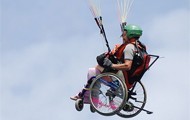Will Our Glaring Stares Burn Others?:
 Staring:How We Look
Staring:How We Look
Rosemarie Garland-Thomson
Oxford University Press, USA
2009-4-17
244
USD 24.95
Paperback

In the subway packed in like sardines, you luckily get a seat, and leisurely play on your mobile phone with your head down. Tired, you raise your head to relax, and suddenly notice that the man standing before you is a little odd. The right side of his face is fairly normal, but the left side is wrinkled and full of bumps and hollows, with purple black spots all over, aging the left side far more than the right. His jaw and neck are stuck together, and he has extruding buckteeth. He looks exactly the same as the old man in the picture below. If this were to happen to you, what would be your reaction? You would be startled, and then what? Would you choose to stare at him, wondering where this “freak” came from? Or would you pretend not to have seen him, keeping your head down because mum has taught you that it is impolite to stare at others? Would you immediately stand up and offer him your seat even though he is stronger than you? What would be your reaction if you were the one being stared at by others? Would you feel uncomfortable but pretend not to care? Or would you just silently remind yourself to wear a mask to cover your face next time? Would you smile at others to show your naturally warm grin? Or would you react just like the old man who gets laughs by imitating the surprised look of others?
Each of us is familiar with the eye contact (stare/watch/gaze/glare) caused by looking “different,” especially readers of Youren who are interested in disability. Staring: How We Look, written by Professor Rosemarie Garland-Thompson of Emory University, investigates how staring, as a form of interpersonal interaction, influences the identity of disabled or appearance-special people. Dr. Garland-Thompson also explores ethics in interpersonal communication. In order to fully understand staring (at least in American culture), the author collected a large amount of visual data on appearance-special people (mainly the disabled) and records on staring, and also interviewed many people who have experienced strange staring for a long time. In the following section, let’s review the book and think about how we usually “look.”
Why do we stare at others? The author of Staring answers this question using knowledge from physiology, psychology, sociology, anthropology and other disciplines. First, staring is a physiological reaction. Animals (including humans) are content with certainty, but when faced with a new and uncertain objective they will reflexively feel surprised and begin to stare in order to seek new information and to become accustomed to the new stimuli or the stimulation of something fresh to return to their peaceful world. In turn, this series of reactions, including staring, will remind the observer of potential danger.
Second, staring is shaped by culture and history. Modern society revolves around our visual sense – it is our most important means of gathering information. In addition, modern medical science, through observation of appearance and anatomy, has taken the “average man” and made it the standard against which all people are compared; anyone who deviates from this standard is abnormal or even dangerous. This medical culture shapes how we look, making us pay attention to appearance-special people, especially those who are explicitly disabled or sick. It makes us examine them closely, and even makes us try to correct them.

Third, staring is built on the basis of social relations. Unlike older societies in which one's dress was an outward expression of one's position in the class structure, modern society's bourgeois values lead to a pursuit of equality among people which requires us to maintain "civil inattention" to others' appearances. At the same time, we have to use eye contact to express respect and recognition for others. There is a delicate balance between civil inattention and recognition attention. For example, when a colleague passes by, we briefly look at each other, nod and smile, and then walk our separate ways. Staring breaks this balance, because it allows the observer to assert his or her dominant position, the observed are stigmatized, feeling humiliated by the exposure of his defects.
Fourth, staring is also a way to obtain knowledge. Sometimes, no matter what social norms require, we just can't stop staring at others. While staring, the observer finds that not only are there different people and modes of existence in the world, but also that his body may be special and fragile, and he may reconsider the relationships between normality, abnormality, health, and disability/disease. Therefore, although staring may bring stigma to the observed, it can bring new knowledge and interpersonal relations as well.
In short, public life in modern society requires us to stare at novel people and objects, which makes the observer rude and the observed shameful. In fact, we want to see these things, and we bashfully see and then pretend not to have seen; but we don't want to be stared at. The disability, deformity and pains of body remind us that the healthy and sound body is temporary because everyone will eventually get diseases and die. Don't we, self-assured in our fine faces, become full of scars after we receive radiotherapy to cure hemangioma in face just like the old man mentioned above? If it does happen, what should we do? Fear is our subconscious response when facing diseases and disabilities. To flee from fear, we quickly look away and return to the illusion of our sound body. Some people even accuse the observed of bringing embarrassment and fear upon themselves, claiming “Being ugly is not your fault, but showing it is wrong.” For example, from the 1860s to the 1970s, several big cities in America, including Chicago, implemented “Ugly Laws” which prohibited ill, disabled or deformed people from appearing or begging in public. No matter which party is responsible for avoidance, disabled people have no dignity or value if they vanish from the public.
Since both staring and ignoring are improper, how should the observed present themselves to others? The author lays out various responses of the observed through interviews and the study of video data. There is no right or wrong for these responses, but they can reveal the recognition differences of special identity (such as disability) of the observed and as a microcosmic strategy of interpersonal communication, different reactions to staring can construct various social relations and values. Those who became recently disabled or have trouble identifying his or her own disability would often cover their special body part in response to staring. For instance, the author mentions an ex-soldier who lost his left hand in war. He prepared 9 different prosthetic limbs for different circumstances: he would use a metal mechanical hand with flexible function when working at home, but would use a decorative hand with simple functionality but lifelike shape when meeting visitors. It made his hand-disability a secret. But he had to choose between function and appearance of the prosthetic limb, and usually he prioritized appearance.

When faced with being stared at by others, some choose to cover up, some would rather withdraw from the public, and some would fight against the humiliation of others' eyes. The old man in the above picture is named David Roche, who endured several painful operations and radiotherapy as a child to cure hemangioma. In order to receive better treatment, he agreed to show his face to doctors. When seeing patients' pictures displayed in the hospital, he understood their fear, helplessness, and anger when under the stare of commanding medicine. While he was standing in the lecture hall being observed by doctors, he found that the doctors simply regarded him as a malfunctioning biological body and stared at his face as a specimen of disease. The doctors all indifferently or anxiously avoided eye contact with him. After observation, the chief doctor said to him, “You have done well in correction.” At that moment, Roche's anger at medicine broke out, and he yelled, “Don't talk correction with me! You have no idea what I have been through! None of you ever asked about my feelings!” Roche, with his outburst, intended to prevent his subjective experiences with blood and fear from disappearing under the authority of medicine. However, the anger for injustice the disabled face is usually taken as a sign of psychological sensitivity and illness. The chief doctor was speechless for a moment and then said to Roche, “Do you need to be transferred to see a psychiatrist?”
After this incident, Roche chose to become a public speaker who guided others to look directly at his face and eyes on the stage, and he led people on a humorous exploration of his ordinary life and unique experience so as to help people reconsider the illusion of “normality” and recognize that life is changeable. In fact, many disabled persons can control and guide others' attention and turn others' staring from an offensive insult into sincere curiosity, concern, and learning through skillful exposition rather than covering their special bodies. For instance, the picture below looks ordinary at first glance: two ladies were leisurely standing by the river and feeling the sun as their eyes looked into the distance. But with a closer look, we can find something unusual: the left lady has a pair of prosthetic limbs under her miniskirt, while the right one holding a camisole has no arms. Are they really strange? Their difference naturally shows through their ordinary summer clothing, but they do not care about others' opinions, including our own. Everything seems so calm and peaceful, and maybe their lives are no different than those of ordinary people. So should we feel strange about our own selves making a fuss? Oh, by the way, the two ladies in the picture are famous disability advocates and researchers from Germany named Gisela Hermes (left) and Theresia Degener (right).
Compared with staged photos, a disabled persons' guidance and control of others' staring in daily life is much more complicated. ‘Staring’ puts forward a four-step strategy to guide staring. First, the observed should be aware of the staring and be prepared; second, he or she should plan the interaction to monitor the staring; third, the observers should be induced to end their staring or shift their staring to places that the observed prefers, such as to keep eye contact or to show the different body in an artistic way like the above picture; fourth, the observed should begin a conversation with the observers to eliminate their speculation by offering information, or even guiding the observers to explore and think in a way similar to Roche. Through this strategy, the observed can make the observers realize they’re staring, and that their staring is noticed by the observed, making them understand he or she has his or her own stories.
Staring is rooted in physiological, cultural and social relations. For the observed, what counts is how they are stared at rather than whether or not they are stared at. Above, we have discussed that the “how” has no right or wrong, but rather concerns interpersonal strategy and identity. Concealing one’s disability certainly can prevent glaring stares. However, the action itself internalizes the self-abasement of being defective, which puts the disabled under the anxiety of exposure. On the other hand, allowing the disabled to actively expose their disability can not only serve as psychological liberation, but also may allow for a chance to reconstruct their self-image and realize growth. For observers, since staring is common, what counts is how to stare rather than whether to stare, because staring may bring new knowledge instead of strengthening prejudice. As observers, we have to realize we are staring at others who intend to attract our attention; this is the beginning of turning our staring to ethical action. During staring, we pay attention to the person in front of us and feel sincere curiosity, allowing us to learn about a different lifestyle with dignity. Such staring leads to appreciation, not harm.
After my longwinded introduction to Staring: How We Look, I want to express my love for this book. As someone who is often the observer and sometimes the observed, I was touched by its depiction of various interpersonal interactions. Of course, I understand this book is written against the background of European and American middle-class culture and society, and that their social norms on staring do not entirely conform to China's. After hearing my introduction to this book, a disabled Chinese friend of mine told me that people on the subway often stare so intensely that they draw closer to get a better look. Is this to be expected?
Have you had any interesting (embarrassing, annoying, or happy) experiences observing or being observed in daily life? Have you ever used the strategy described in the book? Garland-Thompson's book rarely talks about implicit disability (such as mentally disabled people, hearing impaired people, some visually impaired people, and physically disabled people); if you are one of them, can you talk about how would you face others when they discover your disability? Will you actively expose your condition or deliberately hide it? If you have stories to share about staring, please follow our Wechat, “One Plus One,” or write to the editor.






